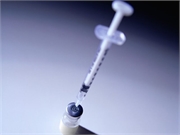- Navigating Your Midlife Crisis: Embracing New Possibilities
- City Raccoons Showing Signs of Domestication
- Mapping the Exposome: Science Broadens Focus to Environmental Disease Triggers
- One Week Less on Social Media Linked to Better Mental Health
- Your Brain Changes in Stages as You Age, Study Finds
- Some Suicide Victims Show No Typical Warning Signs, Study Finds
- ByHeart Formula Faces Lawsuits After Babies Sickened With Botulism
- Switch to Vegan Diet Could Cut Your Greenhouse Gas Emissions in Half
- Regular Bedtime Does Wonders for Blood Pressure
- Dining Alone Could Mean Worse Nutrition for Seniors
CDC Alerts Nation to Prepare for Coronavirus Vaccine by Early November

The U.S. Centers for Disease Control and Prevention is telling the nation to prepare for distribution of a COVID-19 vaccine this fall.
The CDC has notified public health officials across all 50 states that limited vaccine doses might be available by late October, and that they should prepare now as to how the vaccine will be routed to health care workers and other high-risk groups, according to documents obtained by The New York Times.
The documents outline detailed scenarios for distributing two unnamed vaccines — “Vaccine A” and “Vaccine B” — if either or both candidates demonstrate sufficient effectiveness and safety to warrant an emergency use authorization (EUA) from the CDC before clinical trials are fully completed.
Infectious disease expert Dr. Amesh Adalja expressed some skepticism that an effective vaccine will be available that soon, however.
“I think it is essential to prepare for vaccine rollout as soon as possible. However, an October or November rollout seems overly optimistic to me if the usual EUA process is going to be in place,” said Adalja, a senior scholar with the Johns Hopkins Center for Health Security in Baltimore.
“Vaccine programs are going to be a logistical challenge and I’m glad that planning is beginning, but we shouldn’t wed ourselves to a specific date,” Adalja continued. “There are real concerns about meddling in the EUA process, but hopefully that won’t be the case and the requisite amount of data on safety and efficacy will accrue.”
Some experts have expressed concern that the Trump administration may be rushing the distribution of a vaccine, or trumpeting that one is on the way, to help improve the president’s chances of re-election on Nov. 3.
The CDC documents recommend that the vaccine first be given to health care professionals and essential workers, followed by people involved in national security and folks living or working in long-term care facilities, the documents show.
People aged 65 or older, those at increased risk for severe illness, people attending colleges or universities, and Americans serving time in prison or living in homeless shelters are also earmarked as critical populations that should receive early vaccination.
States should plan now for real-time shipment of the vaccine, which would be free but potentially subject to some administration fees, the documents noted. People will likely need two doses of the vaccine, given three to four weeks apart, to achieve immunity, the agency said.
The documents also put forth a schedule of assumed availability of both vaccine candidates, should either qualify for emergency use:
- Vaccine A could have around 2 million doses available by the end of October and as many as 30 million by year’s end.
- Vaccine B could have around 1 million doses available by the end of October and as many as 15 million by the end of the year.
While no specific vaccine candidate is named in the CDC documents, the Times noted there are “echoes” of discussions held at an Aug. 26 meeting of the CDC’s Advisory Committee on Immunization Practices. Vaccine A might refer to a shot undergoing testing from the drug company Pfizer, while Vaccine B could be one under development by another company, Moderna.
The three documents went out on Aug. 27 to all 50 states as well as New York, Chicago, Philadelphia, Houston and San Antonio, the Times reported.
While many Americans have been skeptical of the safety and effectiveness of a COVID-19 vaccine, that wariness may be ebbing, according to a new poll.
Just over 54% of Americans now say they would get a COVID-19 vaccine in the first 12 months after it’s introduced, a significant increase from the 42% who said so in July, the new WebMD poll found this week.
However, only 27% of the 1,000 readers who participated in the survey said they’d get a vaccine within the first three months after it becomes available, which is only slightly higher than 26% who said so in the July poll.
In the new survey, 12.5% of respondents said they wouldn’t get a vaccine at all, and 21.4% said they’re unsure.
More information
The U.S. Centers for Disease Control and Prevention have more about COVID-19.
Source: HealthDay
Copyright © 2025 HealthDay. All rights reserved.










